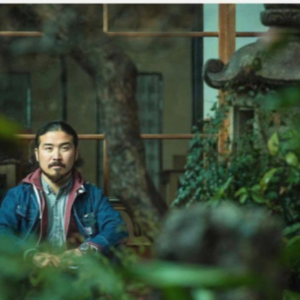 Shogo Ota is a local artist and designer, and the creator of the beautiful mural at our Weller St entrance. We sat down for a chat with Shogo recently, to discuss the mural, his artistic process, and more.
Shogo Ota is a local artist and designer, and the creator of the beautiful mural at our Weller St entrance. We sat down for a chat with Shogo recently, to discuss the mural, his artistic process, and more.
Can you talk a little about your career?
I went to art school in Idaho. I kind of thought that I couldn’t get a job as an artist, but maybe I could as a designer, so I kind of added graphic design, and I was taking art classes and graphic design classes at the same time. Anyway, I graduated and moved to Seattle, and I worked for this small design company for like, six, seven years, in the Greenwood area. I’d always wanted to start my own studio, so I did about 10 or 11 years ago. I work on murals, of course–big, small, size doesn’t matter. I do branding. There are some restaurants and bars in Seattle that I work on: menus, main logos, and other artwork. I do custom illustrations and some music posters for local bands. I don’t really pick one style or one job to proceed with my career. So yeah, that’s what I’ve been doing.
Can you talk a little about your artistic process?
I always ask for input from clients, since I don’t have just one specific style. So I kind of say “Hey, what are you looking for?” And then I ask some questions based on other pieces of mine that they’ve seen. “Do you guys like this? Is this how you envision the art?” And then we do kind of a case study. I give them some sketches. And then we kind of develop the idea together.
How did you approach the design of the Freehold mural?
Red and black are Freehold colors. And also, it’s in Chinatown, and red is associated with Japan, so a strong red is kind of fun. With a strong red background I thought “It’s really gonna pop”–because it’s a little bit hidden on that alleyway. So I wanted to kind of make it stand out when people walk by, like “Whoa, there’s a mural there!” There’s a strong color contrast. I want to make people want to take a picture, you know? The birds are simply symbols of freedom–flying to the great future. I think that’s what Freehold Theatre has been doing with a lot of students, people, and communities.
Is there a special significance in making art in Chinatown/ID?
I was really honored to do it. It’s not just about the mural. I feel like I’m supporting the people and the community.
I have one more project in Chinatown, kind of by the wall under the I-5 bridge, on Jackson. It’s a little dark and kind of a hard environment, but we are planning to clean up a little bit. And then it’s a long–-a super long wall. It’s really short and long. So design-wise, it’s kind of hard to come up with ideas. But I have a couple ideas. And hopefully I’m going to work with youth programs and have volunteer helpers. So, it’s a nice community-involved project. I’m working with another non profit organization and some Asian community organizations are also involved. So, it will take a long time, but I feel really good about being involved as an Asian designer–it makes me really proud.
Where can people find your work?
I have one piece right by the West Seattle bridge. There’s a huge warehouse. It’s like 110 feet wide, and 40 or 50 feet tall. That’s a big one. I needed like four or five volunteer workers from another studio, using my design. And so everyday, two or three people helped me and it took four or five days. It was pretty cool. We had a big sprayer and spray paint–much quicker than using brushes.
And there’s one in Pioneer Square. It’s a Mexican restaurant, Casco Antiguo. But the restaurant closed. I think there’s a new owner and it’s under development right now.
I have one in Edmonds by the ferry terminal. What else? The easiest thing is to go to my website.
Anything else you want to add?
I was really honored to use my skills to support Freehold, but I’m kind of hoping it’s not just for Freehold, but for the community. I hope people look at the mural and then find out about Freehold, and I just hope it creates positivity for people in the community. So I hope I can be the bridge, through the mural. The mural doesn’t talk, but it kind of communicates positive vibes and makes people stop and look. If I can help make that connection, that’d be amazing.
Time-lapse video of Shogo painting the mural


